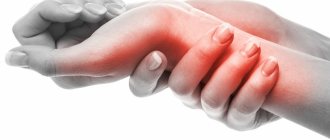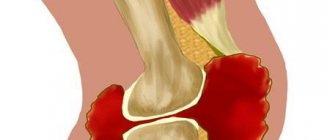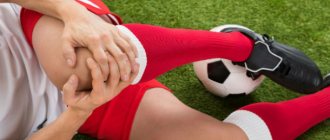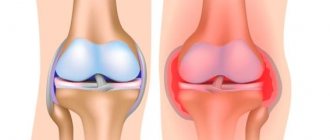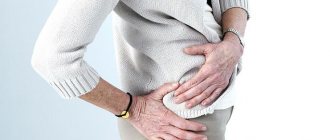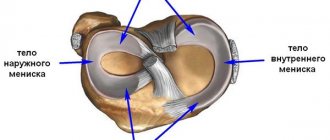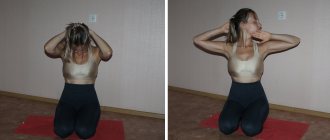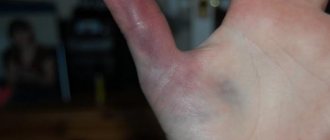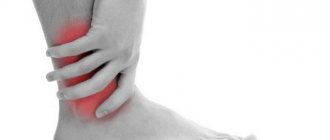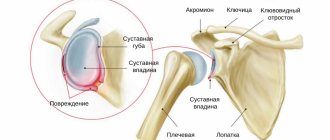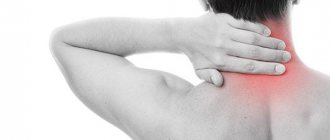Medicine knows many joint pathologies. Despite the similarity of symptoms, it is not so easy to understand how gout differs from arthritis or, say, arthrosis. Therefore, when the first signs of illness appear, you must consult a doctor to make a correct diagnosis. Timely treatment will stop the destruction of joints and save you from many troubles in the future.
Major joint diseases
The problem of joint damage has been known since time immemorial. Humanity encountered it at the dawn of civilization and in medieval times, considering the disease to be the lot of elderly and weakened people. Today, the disease has become noticeably younger - it is increasingly encountered by middle-aged men and women who spend most of the day in the office.
Modern rheumatology initially divides all joint diseases according to etiology:
- arthritis (inflammatory);
- arthrosis (degenerative-dystrophic).
If the disease affects only one joint, they speak of monoarthritis/monoarthrosis. If more joints are diseased, polyarthritis/polyarthrosis is diagnosed.
Each group of pathologies has its own typical symptoms, but in most cases they are very similar, so only a doctor can differentiate the disease.
Arthritis
Arthritis refers to inflammation of the joints. At its core, it is a collective term that unites several types of joint diseases: allergic, rheumatoid, psoriatic, purulent, tuberculous and other forms.
According to the clinical course, inflammation can be acute and chronic. The pathological process involves cartilage, the inner layer of the joint capsule, synovium, capsule and ligaments.
Gout
People who are far from medicine believe that gout and arthritis are the same ailment. Let's see if this is true.
According to the ICD10 code, metabolic disorder belongs to the heading “Diseases of the musculoskeletal system and connective tissue,” classified as inflammatory polyarthropathies.
Thus, it becomes clear that urate disease is only one type of arthritis. Its peculiarity is a violation of purine metabolism, and not damage to the joints, although the disease manifests itself precisely in severe pain in the joints.
Previously, older, overweight men who loved to drink and eat delicious food suffered from systemic disorder. The joint of the first toe, a favorite place for the accumulation of urates (uric acid salts), became swollen and painful. Today, the symptoms of gout have become smoother, attacks occur less frequently and are milder, but the disease increasingly affects several joints and is more difficult to treat.
Arthrosis
Arthrosis is not an inflammatory disease, but a degenerative-dystrophic one. It is otherwise called deforming osteoarthritis (DOA). Affects several joints at the same time, with the exception of the post-traumatic version.
DOA most often affects people who expose themselves to extreme physical stress, for example, professional athletes. Office workers who spend a lot of time in a sedentary state are also prone to dystrophic disease.
The disease is based on dystrophic changes in cartilaginous tissues, deterioration in the production of synovium, bone growths (osteophytes), calcification of joints and, as a consequence, destruction of joints. Therefore, arthrosis is largely considered a disease of the elderly.
Diagnostics
Doctors usually begin diagnosing rheumatoid arthritis or gout by taking a patient's medical history and asking them questions about their symptoms. In addition, doctors are interested in diet, medications taken and the presence of any other chronic diseases.
A specialist may perform a physical examination, which can usually identify all the areas where symptoms are occurring. For example, if a patient has gout, he will most likely experience pain in his big toe.
Doctors also offer patients to donate blood for testing. If a person has gout, the level of uric acid in the blood is likely to be high. In addition, the patient may also be recommended blood tests for markers, the levels of which tend to increase in rheumatoid arthritis. These markers include the following:
- antibodies to cyclic citrullinated peptide;
- C-reactive protein;
- erythrocyte sedimentation reaction;
- rheumatoid factor.
To check for soft tissue or bone damage, doctors may suggest imaging tests, such as X-rays or magnetic resonance imaging (MRI).
Imaging tests can identify deposits of uric acid crystals in the joint area and notice signs of joint inflammation, which may indicate rheumatoid arthritis.
Alternatively, your doctor may remove fluid from a swollen joint using a special needle and then test the fluid for the presence of uric acid crystals, which may indicate gout.
Compare arthritis and gout
Like other types of arthritis, gout affects the joints. But if a rheumatoid disease forms lumps and nodules, deforms symmetrical areas and reduces mobility, in the traumatic version a specific joint is affected, then uric acid deposition is observed on one big toe and occasionally in the wrist area.
A biochemical blood test can help identify gout.
In order to correctly diagnose these ailments, in addition to interviewing the patient and visual examination, they resort to laboratory tests. For gout, a biochemical blood test is additionally performed to determine the level of uric acid.
Causes
Metabolic disorder is most often observed in middle-aged men; women suffer from the disease much less often. A predisposition to a disorder of purine metabolism can be hereditary or acquired, associated with obesity, bad habits, and abuse of meat foods.
Other causes of gout:
- long-term use of diuretics;
- surgical intervention;
- hemolysis;
- radiotherapy and chemotherapy;
- presence of concomitant diseases.
The culprits of arthritis are autoimmune and infectious pathologies, damage to the body by Trichomonas, chlamydia and other STIs. One of the common causes of the disease is stress, emotional distress, and nervous shock.
It has been noticed that the inflammatory process is not limited to the joints - the disease often affects the heart, increasing the risk of developing heart attacks.
Joints suffer when a large amount of lead or aluminum salts enters the body, which happens when working in hazardous industries or illiterate use of certain medications.
Manifestations of the disease
The symptoms of gout and arthritis are similar: joints in the arms and legs become inflamed and painful, subcutaneous lumps form, and mobility is lost. Both diseases lead to deformation of cartilage tissue.
However, despite the similarity of the clinical picture, the diseases must be distinguished. A comparison table will help you do this.
| Gout | Arthritis | |
| Gender and age of the patient | More often observed in men after 40 years of age | It affects people of all ages and genders, but more often women over 30 years of age. |
| Main symptoms | Pain, redness of the skin over the lesion, local hyperemia, swelling, hyperuricemia, increased triglyceride concentrations, persistent hypertension. | Stiffness of movement is accompanied by swelling, pain in the joints, inflammation, and hyperemia. |
| Onset of the disease | The first attacks of gout are sudden and short-lived. The attack most often begins at night. | Arthritis can begin immediately and be accompanied by severe discomfort (acute form) or develop over a long time, reminding itself of periodic pain (chronic disease). |
| Which joints are inflamed? | Most often, one joint on the big toe is affected. Less commonly affected are the joints on the hands, knees and elbows. | Inflammation affects all joints, but the small cartilages of the hands, knees, shoulders and pelvic area are most vulnerable to arthritis. |
| Nature of pain | The slightest touch to the affected area causes severe pain. | With arthritis, discomfort is less pronounced and occurs only with movement. Pains of a “volatile” nature are observed. |
| Symmetry of the lesion | Yes | No |
| Stiffness in the morning | No | Yes |
| Skin changes | Rheumatic nodes and bumps | Subcutaneous tophi |
| Increased body temperature | May be | May be |
| Associated ailments | Obesity, deterioration of general health, lethargy. | Fatigue, weakness, loss of performance, sweating, possible weight loss. |
The course of the disease in both cases is wave-like - periods of remission are replaced by exacerbation. The painful condition is aggravated by hypothermia, influenza, sore throat, and ARVI.
Treatment of joint pathologies
Modern tactics of combating joint ailments provide for complex treatment. Drug therapy for gout consists of stopping an acute attack and eliminating the symptoms of the disease itself.
To relieve pain and inflammation, the patient is prescribed the following medications:
- NSAIDs - Movalis, Ibuprofen, Diclofenac, Voltaren;
- glucocorticoids - Prednisolone,
- colchicine (colchicum preparation);
- analgesics - Paracetamol.
All medications considered are taken only after meals and for no longer than 7 days. A decoction of flaxseed or milk will help protect the gastrointestinal tract from the negative effects of drugs.
NSAIDs are used to relieve pain due to arthritis and gout.
For the treatment of gout itself, Allopurinol is prescribed. It is taken in the absence of contraindications and side effects for several months or years.
For arthritis, you cannot do without prescribing chondroprotectors that prevent the destruction of cartilage tissue: Teraflex, Artra, Glucosamine + Chondroitin.
During the period of remission, warming and anti-inflammatory ointments are used:
- Apizartron;
- Voltaren Emulgel;
- Ketoprofen;
- Espol;
- Deep relief;
- Dolgit;
- Ortofen:
- Indomethacin.
Folk remedies can be a serious help in the treatment of joint pathologies. It is only important to consult a doctor before treatment and choose the most effective and safe recipes for yourself.
So, what does alternative medicine offer:
- baths with chamomile, pine needles, bran and alkaline solutions;
- alcohol lotions;
- ointment with turpentine;
- birch bud balm or mustard-salt compress with paraffin.
For arthritis, rubbing the sore spot with fir oil or applying mustard plasters helps a lot.
Lifestyle
Proper organization of the patient’s life plays a huge role in the treatment of arthritis and gout. Sometimes more depends on following a diet and correctly calculated exercise than on taking medications.
Let's consider the basic provisions for organizing the patient's regimen.
| Gout | Arthritis | |
| Authorized Products | Milk, cheese, eggs, fish caviar, various cereals, nuts, honey, vegetables and fruits. You can eat bread and flour products; it is advisable to limit sweets, although they are not completely prohibited. | Vegetables, kefir, cottage cheese, fermented baked milk, yogurt, sour cream, chicken, rabbit, cereals, fish. Fruits and berries are allowed to be consumed, but not all and only after consulting a doctor, since many of them contain acid. |
| Prohibited Products | Legumes, most types of meat, offal, sardines, mackerel, sunflower and butter, rich broths. | Tomatoes, onions, milk, fatty meat. |
| Physical activity | Gymnastics for gout should be aimed at improving metabolism - these are various exercises for stretching, rotation, flexion and extension. Yoga helps a lot. | Moderate physical activity is required during remission. All exercises are performed in a lightweight version and under the supervision of an instructor. In the future, you can switch to independent control. Swimming is very beneficial. |
| Patient's daily routine | Bed rest during an attack. | Simple movements are recommended. |
| General Tips | If you have gout, be sure to drink plenty of fluids - alkaline mineral waters, milk, oatmeal jelly. | With arthritis, it is very important to monitor your psycho-emotional state and avoid stress and nervous breakdowns. |
| Small meals, elimination of excessive physical activity | ||
Both diseases require a serious approach and adherence to certain rules, so you should not self-medicate. Only a doctor can correctly diagnose the disease and prescribe therapy.
Causes and risk factors
Regular consumption of alcohol increases the risk of developing gout
Rheumatoid arthritis is caused by problems with the immune system, although doctors don't know exactly why some people develop this medical condition and others don't.
People who have the following risk factors are more likely to experience rheumatoid arthritis.
- Why does a low uric acid level of 264 µmol/l mean a severe attack of gout?
- Age. According to the US Centers for Disease Control and Prevention, rheumatoid arthritis usually begins to affect people after age sixty.
- Floor. Women experience rheumatoid arthritis more often than men.
- Genetic factors. A family history of rheumatoid arthritis increases your risk of developing this disease.
- Body mass. People who are obese are more likely to develop rheumatoid arthritis.
- Smoking. People who smoke or were exposed to cigarette smoke in the womb are more likely to develop rheumatoid arthritis.
Psychosomatics of arthritis and gout
A diagnostic method such as psychosomatics (psychoanalysis) not only reveals the cause of the disease, it builds a psychological portrait of the patient.
Thus, gout develops in power-hungry people who have not found a way to express themselves. Often such a person seems quiet and good-natured, but at critical moments he shows a lack of flexibility and even stubbornness.
Arthritis often occurs in people who are too hard on themselves, suffer from internal conflict and the inability to express their own desires or do what they want.
The result is resentment towards others for inattention and unjustified hopes, and a desire to take revenge on the world or a specific person appears. However, all these feelings are carefully hidden, and ultimately provoke neurosis and joint problems.
How to distinguish arthrosis from gout and other diseases
Recognizing arthrosis is not as difficult as it seems. Its first symptom is aching pain and aches, which are especially felt in cold weather or after physical exertion.
What is the difference between arthrosis and gout? In the first case, there is a gradual destruction of the joints, and in the second, inflammation of the cartilage tissue. Osteoarthritis occurs to one degree or another in almost all people over 60 years of age. It can be called a disease of the elderly, in which tissue degeneration occurs. This usually affects the knee, shoulder and hip joints.
Prevention of joint diseases
Preventive measures for gout include maintaining a healthy lifestyle, giving up bad habits, moderate physical activity and a diet that limits the consumption of fatty, salty and smoked foods, as well as foods rich in purines.
Patients with large weight are recommended to get rid of extra pounds, monitor the functioning of the kidneys, preventing the onset of urolithiasis.
Prevention of arthritis involves monitoring the general condition of the body, preventing hypothermia and the penetration of viral agents into joint tissue, as well as timely sanitation of inflammatory foci in the body.
Answers on questions
How to determine whether arthrosis or gout has affected the joints of the hands?
Since urate deposition is not initially accompanied by severe pain and swelling, gout is easily confused with arthrosis. In the first months and even years, uric acid disease occurs without specific attacks, so the only way to distinguish between illnesses at an early stage is to do a blood test.
How does gout occur in the fairer sex?
The female version of the disease causes much less trouble than the male one - acute attacks are less common, tophi and the symptom of a “punch” in the bones are practically not observed.
Female gout usually manifests itself as moderate pain in the knee or ankle and severe swelling.
What new treatments for arthritis have emerged?
One of the most significant achievements in rheumatology is associated with the development of a fundamentally new group of drugs - biological agents, the mechanism of action of which is based on the suppression of the synthesis of pro-inflammatory cytokines: interleukin-1 (IL-1) and tumor necrosis factor-alpha (TNF).
Currently, the following “biologic” agents are used to treat arthritis: Remicade, Etanercept and Anakinra (Keneret). All of them can reduce the activity of the inflammatory process, slow down the progression of the disease and significantly improve the patient’s quality of life.
Treatment
Prescription drugs are often used to treat both gout and rheumatoid arthritis
Making a correct diagnosis for people with symptoms of RA and gout is critical because the diseases in question are treated differently.
For gout, therapy includes the following.
- Taking medications to reduce the concentration of uric acid in the body. These medications include colchicine, which can be taken both for acute attacks of gout and to prevent symptoms in the long term.
- Taking medications to suppress uric acid production, such as allopurinol, or to remove it, such as probenecid. These medications help prevent gout attacks.
- Taking medications to reduce acute inflammation, such as nonsteroidal anti-inflammatory drugs (NSAIDs).
- Making dietary changes, such as avoiding foods and drinks that trigger gout.
People can slow or stop the progression of rheumatoid arthritis by taking medications that reduce inflammation in the body and suppress the immune response associated with it.
For rheumatoid arthritis, therapy includes the following:
- taking disease-modifying antirheumatic drugs (DMARDs);
- taking biological response modifiers (biological agents).
Patients often have to try several different medications before finding the one that works best.
An anti-inflammatory diet, as well as positive lifestyle changes such as quitting smoking, losing weight and regular physical activity, also help slow the progression of rheumatoid arthritis.
